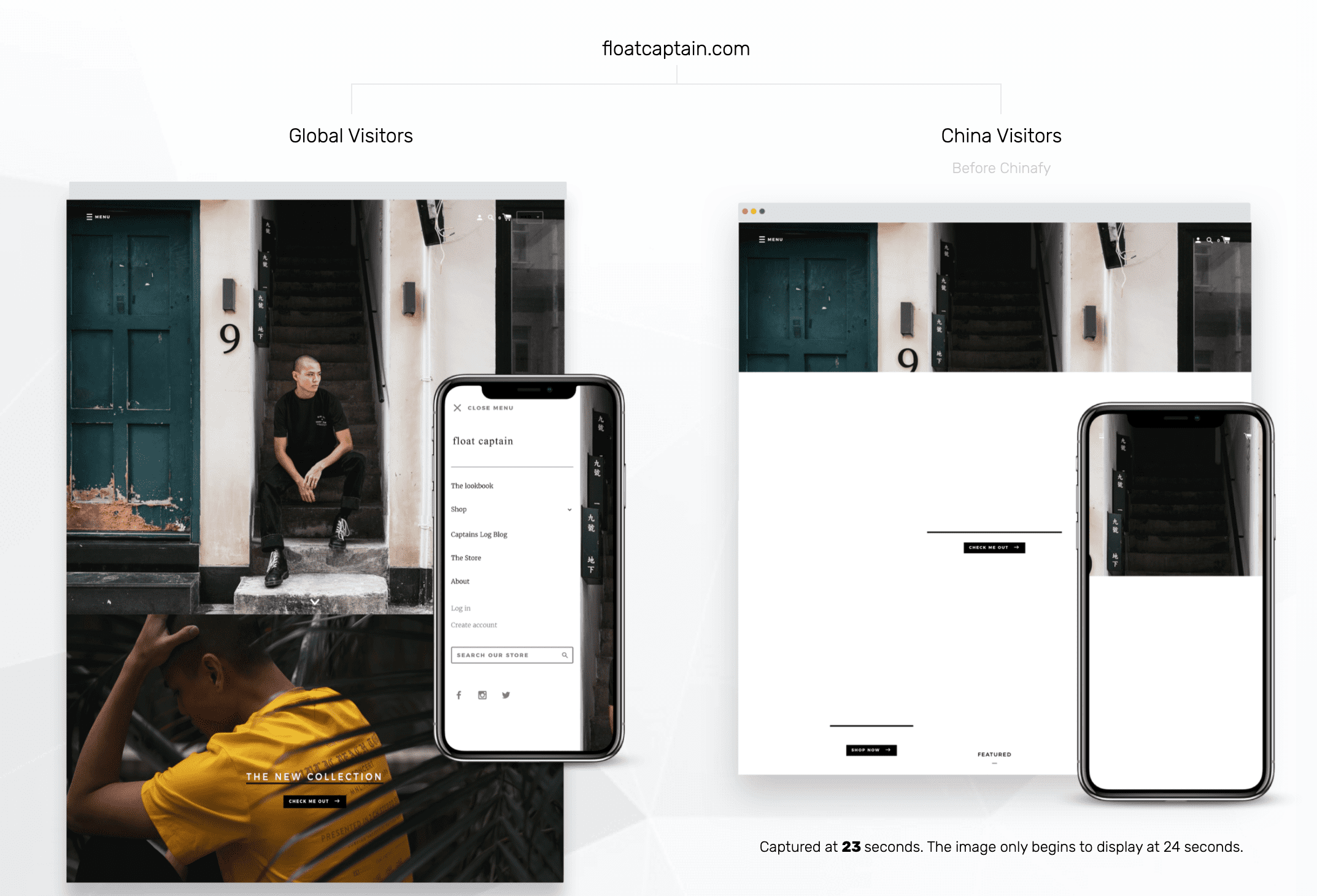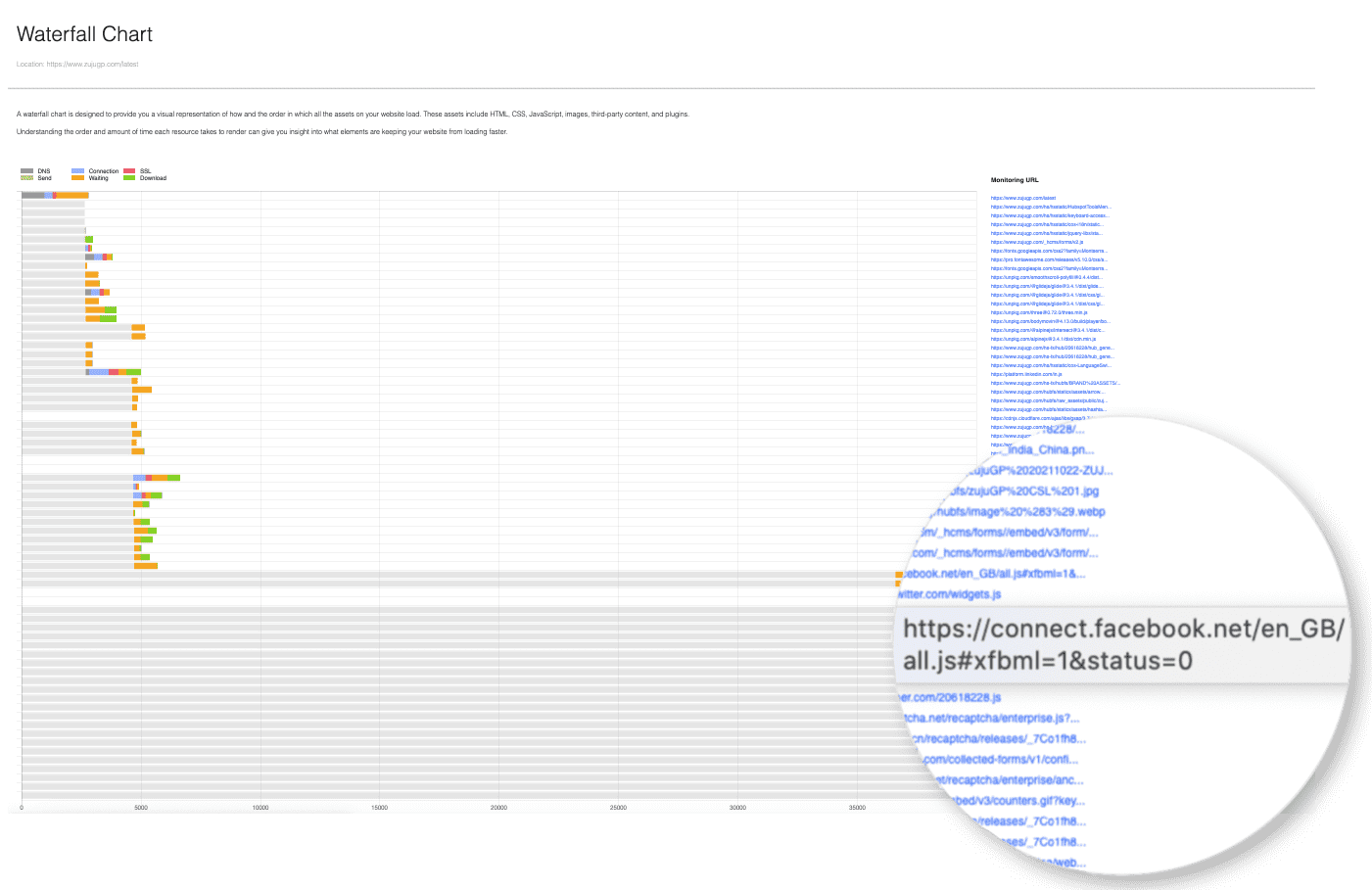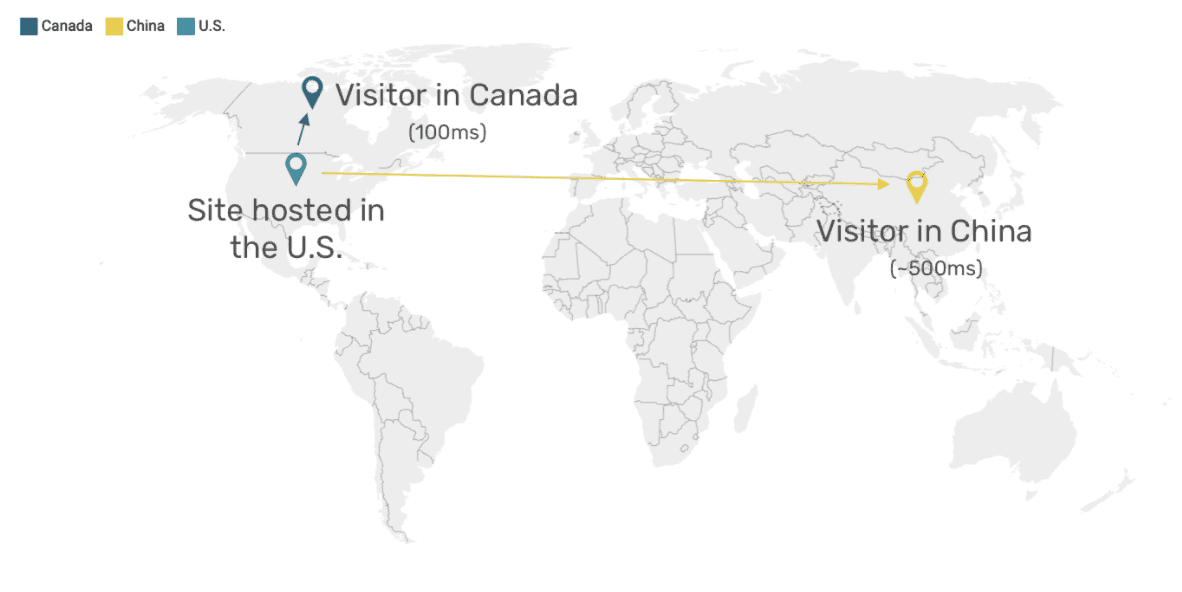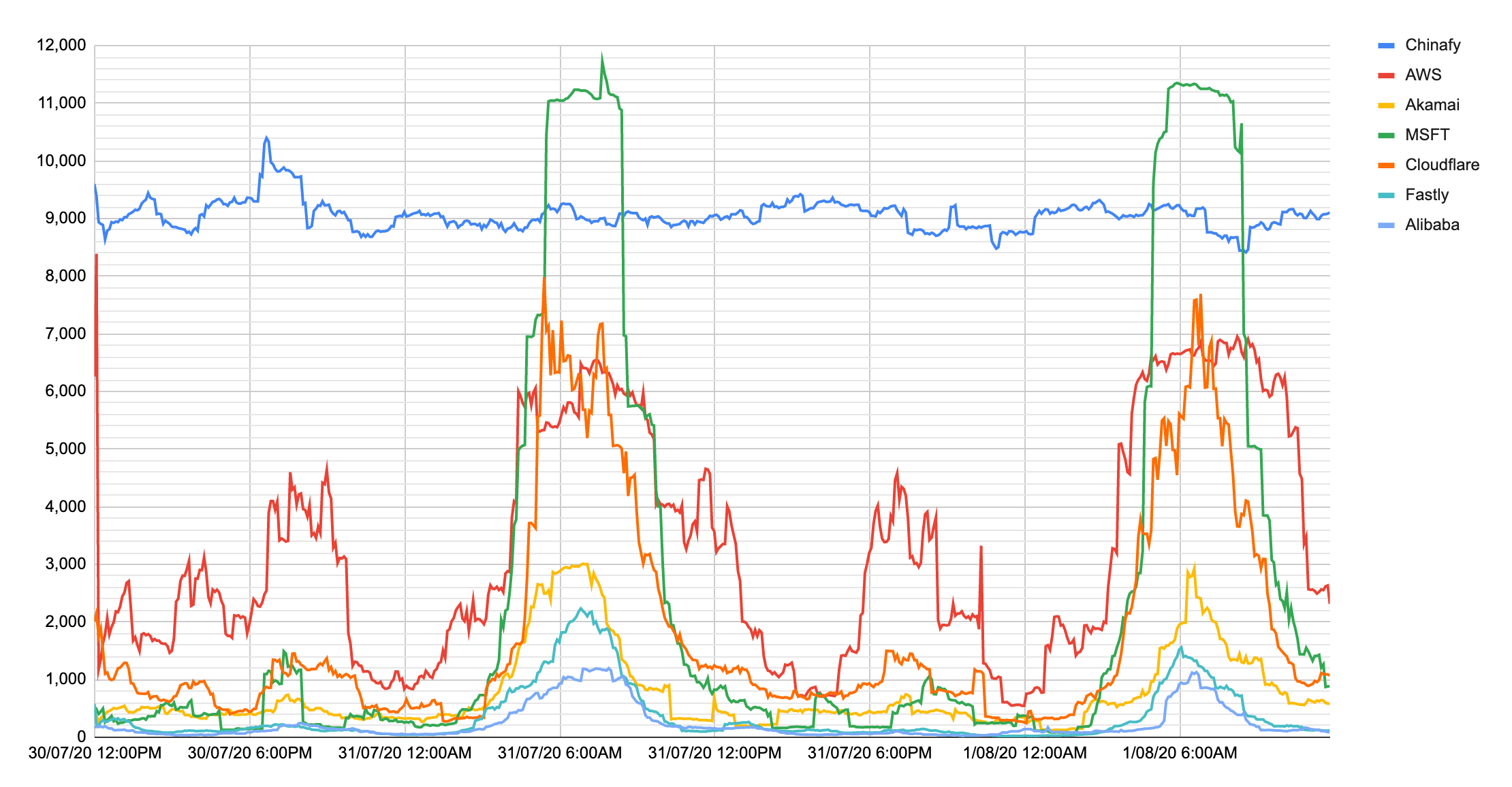1 - Expected post-Chinafy results
Why websites don't work in China
TL;DR Websites don’t work in China for three primary reasons:
i) They are officially inaccessible from China (e.g. Facebook / Google)
ii) They have code-based incompatibility issues in China; and/or
iii) They have infrastructure-based issues in China
Does it mean all websites are inaccessible in China? Not quite. Chances are that most sites actually appear broken and are mistaken as inaccessible because of technical challenges they have when loading from China.
In this article, we'll explain common technical issues websites face in China and suggest various ways to fix them.
First, let's define 'work'.
Anyone who's ever tried to access websites in platforms know that websites simply don’t work the same in China as they do elsewhere.
Websites that aren't officially blocked or inaccessible, can still appear to be broken because simply -
i) They need much longer to load in China than they do elsewhere (i.e. 30 seconds+)
ii) Critical assets (e.g. images, and videos) fail to load

These issues are most commonly a result of building those websites with code, plugins and third party resources that are incompatible with the Chinese internet and an infrastructural set-up that does not perform well from China.
With this in mind, let's break down the technical reasons behind this behavior.
What are code-based issues when it comes to China?
There are a number of technologies that are blocked or slow to load in China.
This includes essential libraries widely used by developers globally, popular plugins, and or default components that website building platforms inherently include out of the box.
Most modern day websites are made up of hundreds of these resources.
Example of third-party resources that are blocked include Google APIs, Vimeo, Youtube, Facebook, and more. Other primary and or third party resources*, while not blocked or inaccessible in China - may be delivered from networks that perform slowly in China (i.e. Amazon S3).
Defining Primary vs. Third-Party Resources: Primary resources are defined as web resources hosted on the primary website domain (www.website.com) vs. third-party resources which are hosted and managed by third party providers (e.g. assets.webcms.com, apis.google.com)
What happens when the browser attempts to load blocked or slow technologies from China?
First, a little background on how websites generally load -
A Request is made for HTML document
The web server provides HTML to a web browser to read
The web browser reads HTML files to identify where to find resources
Browser requests resources - including images, CSS, and js files - from the server(s)
The browser parses these files
Finally, the browser then renders (or displays) the webpage
When a browser attempts to load a blocked resource, the web browser will keep trying to retrieve the file for a period of time before it moves onto the next resource. As a result, the loading process get's 'stuck'.
So, not only does that blocked resource
i) interfere with the total loading time of the website in China, but also
i) impacts the functionality of a site when, after multiple attempts, the site or parts of its content doesn't load at all.
Below is an example of a waterfall chart when a China visitor attempted to load resources past Facebook trackers.
Note that by 35 seconds, only 30% of this website's resources have successfully loaded.

What happens when your site has blocked or slow-loading resources?
You end up with a site that loads both partially and slowly, at times taking upwards of 30 seconds
What are infrastructure-related issues when it comes to China?
Most websites - irrespective of how they're built (e.g. WordPress, Shopify, Adobe, Drupal) - do not have an infrastructure that's specifically designed for China.
This is not as much of an issue for markets outside of China, as even distanced regions generally are able to load within similar time ranges. However, the Chinese internet has been created to be a little different from the rest across both management, regulations, and behavior.
Wix even has said officially -
"It is currently not possible to host a Wix site in China to attempt to make it accessible in the region."
What's the technical limitation there? The two key infrastructural components boil down to
i) choice of servers and
ii) CDN providers.
For example, Squarespace's media assets are hosted in the US and then delivered via Fastly's global CDN. Adobe's media assets are similarly hosted in the US and then delivered via Akamai's global CDN.
This combination of a U.S. server a leading CDN are fantastic for performance. That is, outside of China.
Inside China, not so much.

Does adding a content delivery network (CDN) to your site help?
Yes, but not fully. All CDNs - including China CDNs - deliver some forms of acceleration on the network level across primary resources.
However, when it comes to China this has implications on its efficacy alone. CDNs are not designed to capture, optimise or process third-party resources - the core culprits behind code-based incompatibility issues faced in China.
Blocked resources remain blocked. Slow third-party resources, remain slow.
It's important to highlight that there is the additional factor of CDNs performing quite differently in China depending on the provider.
Below is a speed comparison of all top global CDNs loaded in China including Akamai, Azure, Cloudflare, Fastly and Alibaba.

Y-axis: Bandwidth (in kbps) | X-axis: Averaged over 20-periods (Source: China CDN Considerations)
Fixing China website issues is not so straightforward
It goes without saying that it's not so straightforward to simply remove or replace these resources, or modify a site's infrastructure across website management, hosting, and cloud solutions.
As the state of these blocked or slow technologies are constantly evolving, replacing them poses an ongoing challenge for developers who would need both expertise and multiple dedicated, expert headcount. That is, if they do so without Chinafy (more on that later).
Even if developers were to re-engineer their entire website to replace these technologies and update their infrastructure to make a site work decently in China...
i) the modified version of the site may compromise how the site performs elsewhere. In other words, a tech stack that's suited for China isn't necessary suited for elsewhere.
ii) Technologies and how they perform in China, are constantly evolving. This makes it it difficult, if not nearly impossible, to have the functionality a website may demand that works in a Chinese internet context.
How can you make websites work in China?
Here are a few ways companies make their site work in China.
i) Host websites in China (i.e. the fully onshore route)
You’re legally required to get an ICP license in order to host a website in China.
You’ll also need to manage a list of blocked resources and find China-friendly alternatives on an ongoing basis to evolve your site for the sake of performance.
Need an ICP? Contact Chinafy ICP Support to enquire more.
ii) Use a China CDN (Partial fix)
CDNs are great for accelerate regional delivery - but note that in China...
All CDNs - whether they are onshore within China or near China - are limited in that they do not accelerate third-party resources nor resolve any inaccessible resources in China.
YouTube embedded videos, Facebook trackers on your websites will still be inaccessible, contributing in slow-loading issues on the site level.
More about China CDN comparisons and considerations
iii) Chinafy
Chinafy optimises all websites to achieve near-native performance with an offshore set-up. Hosting in China, at your option.
Chinafy is a highly tuned complex integration of both Software (i.e. Code) and Infrastructure (i.e. Hardware) that can be bolted onto almost any site.
By combining intelligent China-specific resource optimisations with a multi-load-balanced infrastructure, websites are able to achieve significant improvements in performance across the board.
The outcome is an optimised, fully-managed version of any website that's verifiably 6-8x faster in China.
Click "Get Started" to submit your site to Chinafy



1 - Expected post-Chinafy results






























